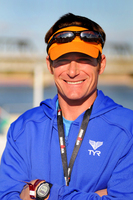Why strength and flexibility training is essential for triathlon success
Author gives triathletes an inside look at how muscles respond to training
Triathletes undergo extensive training to develop the cardiorespiratory endurance necessary for withstanding the rigors of triathlon. But according to Mark Klion, an orthopedic surgeon and 10-time Ironman participant, a successful training program must also incorporate strength and flexibility training. “The goal of a program should be to promote musculoskeletal health and improve the body’s ability to withstand the repetitive stresses placed on it by endurance activities,” Klion explains. “Unlike many other sports such as football or soccer, triathlons require tolerance to prolonged exercise.”
In the forthcoming Triathlon Anatomy (Human Kinetics, 2012), Klion and triathlon coach Troy Jacobson offer over 80 exercises, depicted by full-color anatomical illustrations, for developing the muscles essential for swimming, biking, and running. “The development of strength with sport-specific exercise improves economy of motion, or the ease with which you perform an activity,” Klion says. “This will help you go faster and decrease stress on the body.”
“Athletes should perform sport-specific training before strength work in order to ensure good form and enable solid development of technique,” Klion says. “Muscles that are tired because of resistance training can foster poor movement patterns when swimming and running, thereby impeding efficiency and wasting energy.”
Each discipline in a triathlon requires a coordinated pattern of muscle recruitment that produces motion about the joints and creates the power to make the triathlete move. “As a triathlete transitions from one discipline to the next, a concomitant increase in weight-bearing activity is seen,” Klion says. “Running, the greatest weight-bearing activity of the three, places the most impact on the body and requires a smooth coordination between upper and lower extremities to enable efficient gait.” Klion notes that strength training with both isolated and sport-specific exercises will help develop a strong foundation to create power and speed and also prevent injury.
“Triathletes often like to say, ‘The larger the engine, the faster the train,’” Klion says. “A fast engine that breaks down frequently from overtraining can be problematic and frustrating. A well-thought-out training program that includes strength and flexibility training can create a large engine that runs smoothly. Train smart and stay healthy.”
For more information on Triathlon Anatomy or other triathlon resources, visit www.HumanKinetics.com or call 800-747-4457.



Alexis Koontz
Publicity Manager
alexisk@hkusa.com
(217) 403-7985
Human Kinetics
1607 N. Market Street
Champaign, IL 61820
www.humankinetics.com
Tags:

